View in other NatureServe Network Field Guides
NatureServe
Montana
Utah
Wyoming
Idaho
Wisconsin
British Columbia
South Carolina
Yukon
California
New York
Eastern Heath Snail - Xerolenta obvia
General Description
A medium to large shell, diameter to about 22 mm and height to 6 mm. The shell is depressed heliciform with low spire and 5-6 whorls, the last descending slightly. The aperture lacks denticles (teeth), lip is thin, simple, and only slightly expanded near the umbilicus. The shell is dull, opaque white with a single large dark band above the perifery and up to six paler bands below, some of which may be fragmented or merged; embryonic whorls are brown. Surface smooth or with weak growth lines; the umbilicus is large, 1/4 to 1/3 the shell diameter (Grimm at al. 2009)
Diagnostic Characteristics
The combination of size and shell markings, as well as habitat, are distinctive and unlikely to be confused with any other species in Montana. Native species of the same general appearance do not typically climb vegetation and other upright objects or aggregate in large numbers the way this species does (Grimm et al. 2009)
Species Range
Montana Range
Range Descriptions

 Non-native
Non-native
Range Comments
Native to eastern Europe (Grimm et al. 2009). First detected in Montana in 2012 in southeast Cascade County, the first population reported in western North America (Forsyth et al. 2015); has since been documented in adjacent Chouteau, Judith Basin, and Fergus Counties. Predicted suitable habitat models indicate large portions of lower elevation Montana area suitable for the species.
Observations in Montana Natural Heritage Program Database
Number of Observations: 278
(Click on the following maps and charts to see full sized version)
Map Help and Descriptions
Relative Density
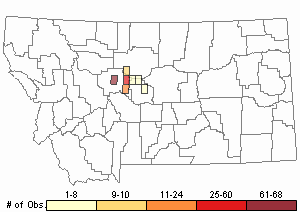
Recency
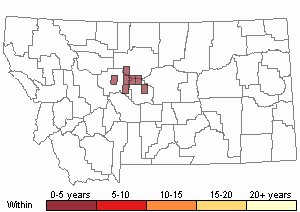
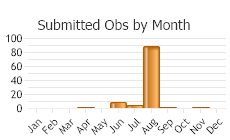
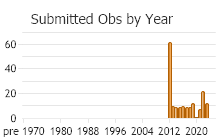
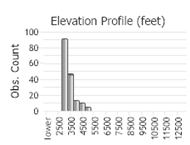 (Observations spanning multiple months or years are excluded from time charts)
(Observations spanning multiple months or years are excluded from time charts)
Habitat
A calciphile; prefers dry, open grassy areas along roads, railways, and old fields, also old ruins and vineyards in Europe (Grimm et al. 2009, Forsyth et al. 2015). Can be found on vegetation, under rocks, boards, or attached to other hard surfaces including homes and barns (Forsyth et al 2015).
Ecology
Feeds on a wide range of plants including, alfalfa, clover, lupine, wheat, barley, fruit trees, and weeds. This species is known for climbing on vegetation, fence posts, and other upright objects to escape high temperatures and will aggregate in enormous numbers in a behavior called massing.
Immature growth and activity occur during spring when temperatures are moderate and monthly rainfall exceeds 30 mm (Lazaridou and Chatziioannou 2005). During hotter, drier times, snails aestivate by climbing on vertical objects, including vegetation, in their environment; during colder periods, they hibernate under vegetation. Survives long periods of dry conditions by withdrawing into its shell and sealing the opening with a mucous membrane (Lazaridou and Chatziioannou 2005).
Reproductive Characteristics
Adult X. obvia lay a single clutch of between 17 and 95 eggs, buried at a depth of 2 cm, and up to 1.5 mm in size (Heller 2001 and Lazaridou and Chatziioannou 2005). Egg-laying activity peaks in October and adults die after laying eggs. One or two generations may result because some individuals live two years and mature in their second year (Lazaridou and Chatziioannou 2005).
Management
The species readily attaches to hard surfaces such as rail cars, international, shipping containers, stone and granite tile, and other conveyances used in international trade. The species is regarded as a pest because it has the potential to reduce crop yield and quality, contaminate fruits, vegetables, and hay, and transmit plant and animal diseases. The Montana Department of Agriculture is working with the United States Department of Agriculture Animal Plant Health Inspection Service (APHIS) to determine the extent of the population and possible local origin of this new to Montana pest. Any sightings of suspect snails should be reported to the Montana Department of Agriculture (406-444-9430 or agr@mt.gov), USDA APHIS (406-449-5210), or your local Montana State University county extension office.
See
Key Findings and Recommendations from the Montana Invasive Species Council's Eastern Heath Snail Science Advisory PanelFor information and resources on plant pests and diseases see the USDA's Animal and Plant Health Inspection Service's
Plant Pests and Diseases ProfilesUseful Links:Central and Eastern Montana Invasive Species TeamMontana Invasive Species websiteAquatic Invasive SpeciesStewardship Responsibility
References
- Literature Cited AboveLegend:
 View Online Publication
View Online Publication Forsyth, R. G., M. J. Oldham, E. Snyder, F. W. Schuler, and R. Layberry. 2015. Forty years later: distribution of the introduced Heath Snail, (Xerolenta obvia), in Ontario, Canada (Mollusca: Gastropoda: Hygromiidae). Checklist 11(4): Article 1711. 8 p.
Forsyth, R. G., M. J. Oldham, E. Snyder, F. W. Schuler, and R. Layberry. 2015. Forty years later: distribution of the introduced Heath Snail, (Xerolenta obvia), in Ontario, Canada (Mollusca: Gastropoda: Hygromiidae). Checklist 11(4): Article 1711. 8 p. Grimm, F.W., R.G. Forsyth, F.W. Schueler, and A. Karstad. 2009. Identifying land snails and slugs in Canada: introduced species and native genera. Canadian Food Inspection Agency, Ottawa, ON. 168 pp.
Grimm, F.W., R.G. Forsyth, F.W. Schueler, and A. Karstad. 2009. Identifying land snails and slugs in Canada: introduced species and native genera. Canadian Food Inspection Agency, Ottawa, ON. 168 pp. Lazaridou M. and M. Chatziioannou. 2005. Differences in the life history of Xerolenta obvia (Menke, 1828) (Hygromiidae) in a coastal and mountainous area of northern Greece. Journal of Molluscan Studies 71: 247-252.
Lazaridou M. and M. Chatziioannou. 2005. Differences in the life history of Xerolenta obvia (Menke, 1828) (Hygromiidae) in a coastal and mountainous area of northern Greece. Journal of Molluscan Studies 71: 247-252.
- Additional ReferencesLegend:
 View Online Publication
View Online Publication
Do you know of a citation we're missing? Bureau of Business and Economic Research. 2022. The Potential Economic Costs of the Eastern Heath Snail to the State of Montana. University of Montana. Missoula, MT.
Bureau of Business and Economic Research. 2022. The Potential Economic Costs of the Eastern Heath Snail to the State of Montana. University of Montana. Missoula, MT.
- Web Search Engines for Articles on "Eastern Heath Snail"
- Additional Sources of Information Related to "Snails / Slugs"





